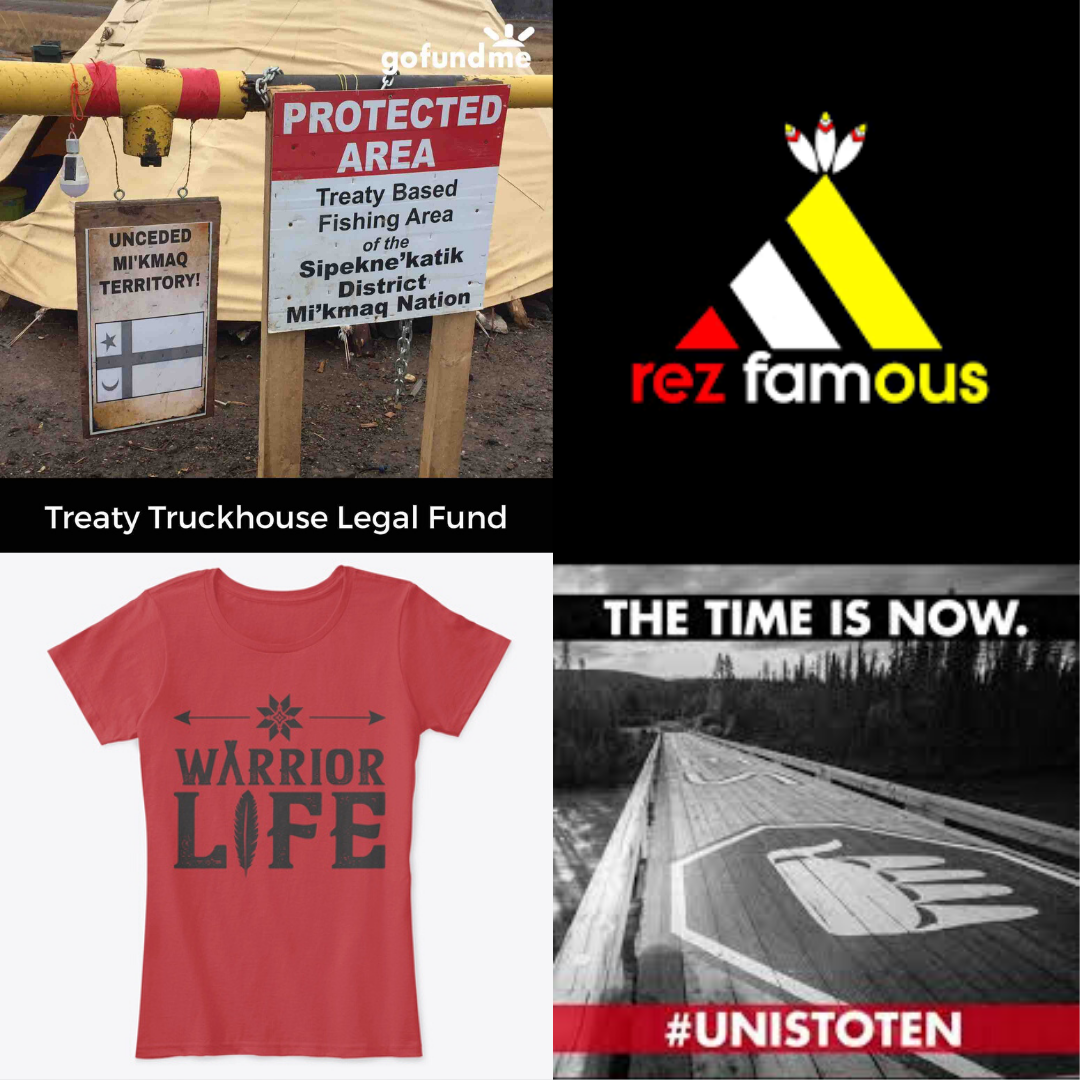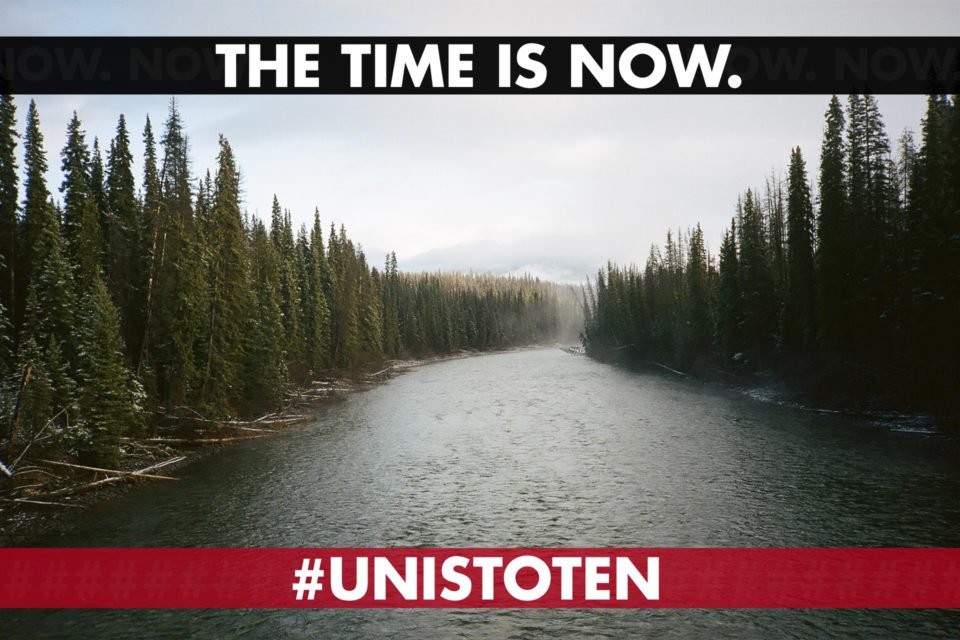
RCMP invades Wet’suwet’en territory. Photo by Amber Bracken; Jan. 7, 2019
While Prime Minister Justin Trudeau makes flowery public speeches about respecting the rights of Indigenous peoples and reassures the international community that there is no relationship more important that the one with Indigenous peoples, Canada invaded sovereign Wet’suwet’en Nation territory. When questioned about this aggressive move at a Liberal fundraiser in Kamloops, British Columbia, he responded: “No, obviously, it’s not an ideal situation… But at the same time, we’re also a country of the rule of law.” Canada’s invasion of Wet’suwet’en territory through its national police force, the Royal Canadian Mounted Police (RCMP), is an example of the blatant violation of the rule of law in favour of corporate interests. Canada has consistently failed to follow the rule of law when it comes to Indigenous peoples, and the violent arrests of the Wet’suwet’en people at the Gidimt’en checkpoint, set up in support of the Unist’ot’en homestead, is a glaring example of Canada’s lawlessness.
The people of Wet’suwet’en Nation, as represented by their traditional government, have long asserted their sovereign jurisdiction over their Nation’s lands which span about 22,000 square kilometres in northwest British Columbia. These lands have never been ceded, nor have their rights to use, manage, protect or govern these lands been extinguished in any way. The Nation has never signed any treaty or constitutional agreement that has specifically surrendered their sovereignty as a Nation. While there have been many federal and provincial laws that have interfered with First Nation laws in general, there has never been an explicit extinguishment of Wet’suwet’en laws and jurisdiction over their Nation’s sovereign territory. Their land rights are not only recognized in Canada’s Constitution Act, 1982, but they are also protected in numerous international treaties and declarations, like the United Nations Declaration on the Rights of Indigenous Peoples (UNDRIP). In other words, there was no legal basis for Canada to invade their territory.
The Wet’suwet’en Nation is a governing Nation that has existed since time immemorial. They are made up of five clans: Gil_seyhu (Big Frog), Laksilyu (Small Frog), Gitdumden (Wolf/Bear), Laksamshu (Fireweed), and Tsayu (Beaver). The Wet’suwet’en are organized through a system of hereditary leaders and have a complex system of governance. While Canada did force the chief and council system on First Nations through the Indian Act, it was not successful in extinguishing or displacing the Nation’s traditional government. This is evidenced in the fact that when the Wet’suwet’en Nation decided to assert their land rights in Canada’s courts, they did so as a Nation, through their traditional government as represented by their hereditary leaders.
In Delgamuuwk v. British Columbia (1997), the Wet’suwet’en, together with the Gitksan, asserted title to their lands. While the issue was ordered back to trial, the Supreme Court of Canada (SCC) made significant findings about the nature of Aboriginal title being a right to the land itself. The SCC found that the land is held communally, by all members of the Aboriginal Nation for their “exclusive use and occupation,” and that this right to land was protected in “pre-existing systems of aboriginal law” and Canada’s common law, even before the protection of Aboriginal rights in section 35 of the 1982 Constitution Act. No laws have since extinguished Wet’suwet’en rights with regards to their territory. Also significant is the fact that according to SCC jurisprudence, Aboriginal title contains an inherent limitation, in that title lands can’t be used in a way that is “irreconcilable” with the nature of the Nation’s attachment to those lands. The SCC explained it this way: “Implicit in the protection of historic patterns of occupation is a recognition of the importance of continuity of the relationship of an aboriginal community to its land over time.”
What can we take from this case? Well, according to Canadian law, we know that it is the “Aboriginal Nation,” in this instance the Wet’suwet’en Nation, that has the legal ownership of their traditional territories, not an individual band. So it matters little that some of the bands may have signed an agreement with the pipeline company, especially if they did so in relation to territory off the reserve and without the free, prior and informed consent of the people. We also know that the lands are not held by individuals, but by the whole Nation. Thus any decisions in relation to those lands rest with the Nation. We also know that the purpose of section 35 is to protect the many ways in which Aboriginal Nations enjoy their title lands and these Nations can’t use them in ways which are inconsistent with those uses. The SCC specifically stated that if Aboriginal title lands are used as hunting grounds, then the land can’t be used in a way that destroys its value – as in strip mining.
In the present case, not only were the Wet’suwet’en people using and occupying their lands, they were also protecting their lands from destruction by the Coastal GasLink pipeline slated to go through their territory. If Aboriginal Nations can’t risk destroying their title lands for extractive projects, certainly corporations should not be permitted to do so. It’s also clear that despite the media reports, this was never about a protest. This was always about occupying and protecting their lands – something they have the legal right to do. This is where the so-called “rule of law” comes into play. The rule of law is touted by Canada every time it actually wants to break the law; according to the United Security Council, rule of law means:
All persons, institutions and entities, public and private … are accountable to laws that are publicly promulgated, equally enforced and independently adjudicated, and which are consistent with international human rights norms and standards.
It becomes very clear then, that Canada has a long history of breaching the rule of law when it comes to First Nations. In the Wet’suwet’en case, Canada has prioritized the extraction interests of a corporation over the constitutionally protected rights of a sovereign Aboriginal Nation. This is a clear violation of the law. The Wet’suwet’en right to occupy and protect their territory is an internationally recognized human rights norm, now reflected in UNDRIP. Article 8 provides the right of Indigenous peoples not to be subjected to the destruction of their culture – something that would naturally come from destruction of their lands and waters with a pipeline.
Article 10 provides that Indigenous peoples will not be forcibly removed from their lands or territories – as was done by the RCMP who arrested and removed Wet’suwet’en people from their own lands. Articles 25 and 26 specifically protect the rights of Indigenous peoples to own, use and control their traditional lands, waters, coastal seas and resources and further protects their rights to “uphold their responsibilities to their future generations in this regard.”
Not only has Canada committed to implement UNDRIP into law, it is legally bound by many other international human rights treaties that it has ratified. While UNDRIP may not yet be law in Canada, it represents the minimum international legal norms for recognizing the core human rights of Indigenous peoples – something that Canada’s rule of law requires. Canada has also issued a directive on how it should engage with Indigenous peoples on litigation relating to their rights, which Canada claims is based on reconciliation with Indigenous peoples and respect for their legal rights. Former Minister of Justice Jody Wilson-Raybould made the bold claim that although she was just releasing this directive in January 2019, Canada has been using these rules for the last two years. It is important to note that this directive states that: “Aboriginal rights do not require a court declaration or an agreement in order to be recognized.” This is something the SCC has confirmed many times in its jurisprudence on the duty to consult, accommodate and get consent.
Yet, we know that Canada has not only failed to abide by its own litigation directive, but it has blatantly violated Wet’suwet’en laws, Canadian laws, international laws and its own purported commitment to the rule of law.
When Canada sent the RCMP into sovereign Wet’suwet’en Nation territory to destroy their check points and violently arrest and remove Wet’suwet’en people from their own lands, it became lawless – an outlaw state. It also violated its own litigation directive when the RCMP issued a statement saying that since there has been no court case declaring Aboriginal title, the RCMP were justified in their actions. In denying the Wet’suwet’en their constitutionally protected legal right to enjoy their title lands, Canada has prioritized the private, economic interests of a corporation – Coastal GasLink Pipeline – over the rule of law. As explained by the Wet’suwet’en:
The Unist’ot’en homestead is not a protest or demonstration. Our clan is occupying and using our traditional territory as it has for centuries…. Our homestead is a peaceful expression of our connection to our territory. It is also an example of the continuous use and occupation of our territory by our clan.
In this case, the laws of Canada were neither equally enforced, nor compliant with international human rights standards. Canada is not a country that follows the rule of law. Canada makes and breaks laws to suit its own economic and political interests, which run counter to those of Indigenous peoples. It is time to be honest about it, and call out Canada as an outlaw, and take action to support the Wet’suwet’en Nation, who have occupied their lands since time immemorial.
This article was originally published in Canadian Dimension Magazine on April 24, 2019:

